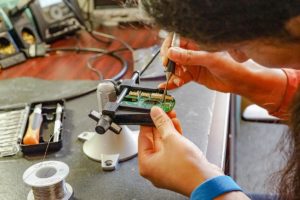Foot drop is a mobility disability resulting from an underlying neurological or muscular injury that affects millions of people nationwide each year. People who have foot drop cannot lift the front of their feet due to weakness or paralysis of the muscles in the feet. This mobility disability can affect one or both feet and can be temporary or even permanent.
Causes of Foot Drop
 There are two main groups of foot drop causes.
There are two main groups of foot drop causes.
One group are neurological disorders, which are diseases of the central and peripheral nervous system that can affect the brain, spinal cord, cranial nerves, peripheral nerves, nerve roots, autonomic nervous system, neuromuscular junction, and muscles.
Common neurological disorders include:
- Multiple sclerosis (MS)
- Lou Gehrig’s disease (ALS)
- Alzheimer’s disease
- Parkinson’s disease
The other group of causes involves the nerves of the body. This group of causes include:
- Nerve injury – The most common cause of foot drop is the compression of a nerve in your leg that controls the muscles involved in lifting the foot, also known as the peroneal nerve. This nerve can also be injured during hip or knee replacement surgery, which may cause foot drop.
- A pinched nerve – A nerve root injury in the spine, also known as a pinched nerve, can cause foot drop.
- Muscle or nerve disorders – These disorders, such as polio or Charcot-Marie-Tooth disease, are inherited conditions that cause the muscles to weaken over time.
- Brain and spinal cord disorders – Disorders such as amyotrophic lateral sclerosis (ALS), multiple sclerosis, or stroke may cause foot drop, affecting the spinal cord and brain.
Foot Drop Effects
People who have foot drop usually drag their toes, as they cannot lift their toes sufficiently to clear the ground. Many develop abnormal compensatory strategies such as lifting their knees higher than usual to avoid dragging the toes, which results in what is called a “steppage” gait. Others are forced to resort to hip circumduction that includes a combination of hip hiking and forward rotation of the pelvis in a large arc.
Whether people drag their toes, have a steppage gait, or have hip circumduction, these abnormalities resulting from foot drop significantly increase the risk of falls. In fact, millions of older Americans are admitted to the hospital as a result of falls or orthopedic injuries due to foot drop each year.
Symptoms of Foot Drop
Foot drop is the inability to voluntarily control the muscles in the foot in a manner to meet the needs of normal gait. The peroneal nerve, which runs near the skin’s surface on the side of the knee closest to the hand, controls these crucial foot muscles that lift the foot. If this nerve is compressed or damaged, foot drop will likely result. Activities that might compress or damage the nerve include:
- Crossing your legs – People who habitually cross their legs can compress the peroneal nerve on their uppermost leg.
- Prolonged kneeling – Occupations that involve prolonged squatting or kneeling can result in foot drop.
- Wearing a leg cast – Plaster casts that enclose the ankle and end just below the knee can exert pressure on the peroneal nerve.
Treatment for Foot Drop
For people with foot drop, there are only a few options available for temporary relief but none that resolve the underlying condition:
- People can be fitted with light-weight leg braces, shoe inserts, or ankle braces called ankle-foot orthotics.
- Physical therapy can be used to strengthen the muscles in the foot to improve walking.
- In some cases, surgery can help some people regain movement.
Solve the Problem of Foot Drop with NextStep Robotics
The pervasive problem of foot drop belongs in the past. NextStep Robotics’ robotic product is the solution of the future. Discover what life can be like without braces or walkers. Reach out to NextStep Robotics today by completing our secure online form for more information about our company and our current and upcoming technological solutions.

